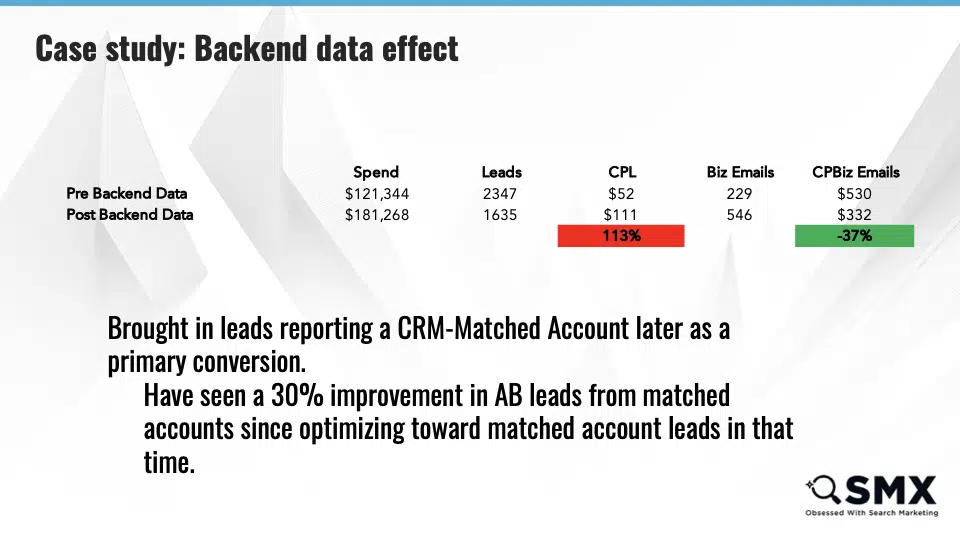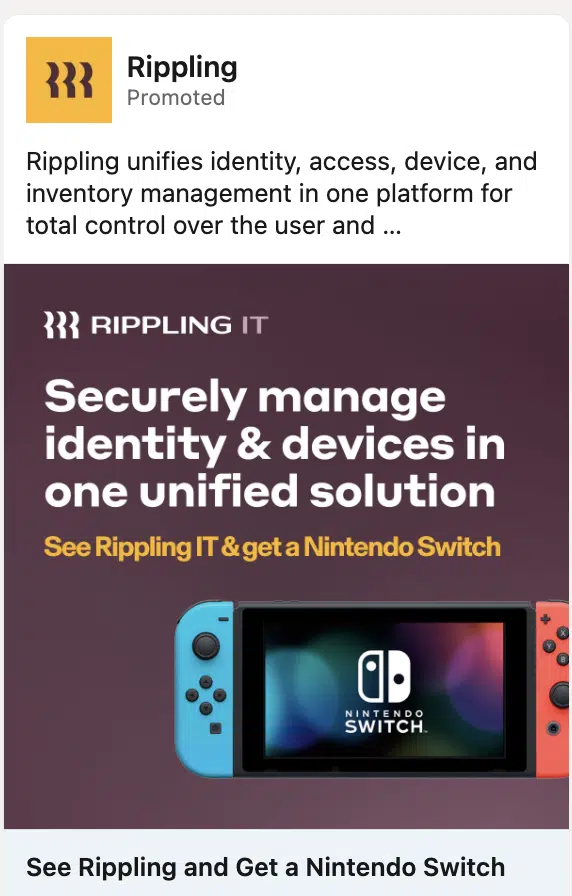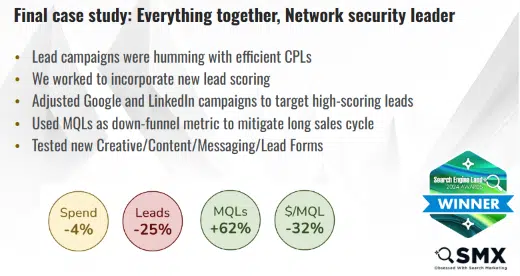How to improve PPC lead quality for B2B campaigns
Get actionable tips for qualifying B2B leads, optimizing paid media channels and using data integration to improve your PPC campaigns.
Lead generation has three undeniable truths:
- It’s easy to drive leads.
- It’s hard to drive quality leads.
- If you deliver poor ones, your sales team won’t be happy.
Nearly every lead gen brand that approaches my agency struggles with driving the right leads.
Despite digital marketing’s constant evolution over the past 20 years, the issue persists.
My recent presentation at SMX Next honed in on how to address this problem by focusing on the initiative to drive better PPC leads.
The core principles of this approach remain consistent:
- Basic lead qualification infrastructure.
- Fluency with media levers.
- Strategic creative.
- Advanced data management and integration.
Let’s take a closer look at each.
Lead qualification infrastructure
As a starting point, make sure you’re set up to do at least manual lead qualification in a CRM instance that captures UTMs and click IDs.
This will give you the basic information about where your leads are coming from.
Part two of this is using a lead scoring tool to identify MQLs and implementing a system that moves the right users through the stages of the purchase journey set up in your CRM:
- SALs (sales-accepted leads).
- Opportunities.
- Customers.
- And whatever the nomenclature is for your business.
Most companies rely on platforms like HubSpot or Salesforce for lead management.
Often, the challenge is ensuring sufficient data density to effectively distinguish strong leads from weak ones.
While some third-party tools can automate lead scoring, ChatGPT offers a practical alternative for evaluating lead strength when manual scoring is time-consuming.
Once you can parse the good leads, you can train the algorithms to find more of them.

Fluency with paid media
Here, we’ll stick with the primary B2B lead channels, Google and LinkedIn.
The main Google levers for successful lead gen are placements and integrated data.
To start, take raw queries and group them tightly by theme.
If your account has any history, it’s essential to break out all queries, including evergreen and high-performing queries.
Then, run an analysis incorporating the CRM data tracking your leads through more advanced stages.
The result: you’ll be able to go beyond CPL and see where to spend your budget if you want to grow your pipeline:

Several other considerations are involved in running effective lead gen campaigns on Google, including saving your budget for the placements most likely to draw quality leads.
First, check your networks on Google.
Do not get sucked in Search Partners unless you’re absolutely maxed out everywhere else.
The platform is hard to manipulate. While you will get leads, they’re almost universally poorer quality than what you’ll find elsewhere in Google search.
You can make a similar case for mobile – plenty of leads, relatively low quality.
But this is due in part to the nature of the platform. It’s harder to read content, which doesn’t lead to deep research.
With mobile, consider lowering your investment until you get the efficiency numbers you’re targeting for later-stage lead activity.
Other campaign types, including Performance Max, display and Demand Gen campaigns, have the same issues: leads are abundant but often fraudulent and bot-driven.
Despite Google’s, at times, heavy-handed encouragement to use PMax, it just isn’t ready for prime time.
You can improve performance by using brand/query exclusions and down-funnel conversions optimization. That said, I recommend leaving it alone for now and focusing your budget elsewhere.
As for LinkedIn, the conversation about driving higher-quality leads starts with the platform’s unique targeting. I recommend you look at:
- Company size: Don’t target small companies for enterprise products or vice versa.
- Titles: Even within the right companies, try to limit sales/business development people because they live on LinkedIn sourcing leads.
Stay tightly aligned with your client (or in-house teammates) to spot opportunities to refine your targeting across channels.
This often involves evaluating lead quality based on geographic location (there can be a ton of variety by geo) and finding small pockets of opportunity specific to the brand.
For example, if a brand has an amazing cluster of salespeople in one geo that makes each quality lead likelier to close, factor that into your strategy.
Dig deeper: Paid search for lead gen: Tips for new accounts with limited budgets
Strategic creative
The B2B industry isn’t known for its earth-shattering creative. However, strategic creative can greatly improve performance with the right users.
Use creative as a qualifying lever.
If you target broadly, use the creative to discuss your desired audience. (Think “enterprise companies” or technical language that dissuades beginners from clicking.)
Expect CTR on these ads to be low.
If you target narrowly, with tight niches, make your messaging accessible and CTR-friendly.
Take, for example, this ad for Rippling, which uses a top-line message with a reward attached.

Last, beware of popular or trendy topics (as I write this, I’m thinking of generative AI).
Unless you have more lead qualifiers in your targeting or creative, popular topics can get you lots of clicks from everywhere. But this can junk up your numbers and your CRM.
I’ll end this section by addressing a question frequently asked by our clients:
- Should you use a form that forces the user to submit a company email address?
My answer is that it is a good idea to test.
On one hand, business emails are worth a lot more than personal emails.
On the other, we’ve seen decent enough performance from non-forced emails to say that they can be worth the increased CVR.
If you have a sales team ready to work leads, put them to use – just make sure they’re on the same page.
(One way around this is to use “enter business email” in the form field but accept all emails anyway – it will still get you a higher proportion of work emails.)
Dig deeper: Google Ads for lead gen: 9 tips to scale low-spending campaigns
Back-end data integration
The idea behind back-end data integration is to train platform bidding algorithms to find the users whose names most resemble the most valuable ones in your CRM.
You will get fewer conversions using this method (which is an expectation you’ll have to set with your clients and/or managers), but the leads will be of higher quality and carry greater intent.
Here’s a recent example from our client portfolio:
We helped a client bring in leads reporting a CRM-matched account later as a primary conversion.
Since optimizing toward matched account leads, we’ve seen a 30% improvement in the proportion of high-quality leads.
Leads will get more expensive using this approach, but the cost per opportunity should decrease.
Note: It’s important to keep feeding more and richer data as you find new metrics that are more predictive of revenue.
Another tactic is to get advanced and use weighted revenue to tie values to funnel events – the lower the engagement in the funnel, the more value it carries.
The caveat is that you need enough data density to use the weights.
Go with the lowest-funnel event with enough data to be useful in training the algorithm (e.g., SQLs if you don’t have enough opportunities).
It’s a starting point.
You’ll have to optimize from there as you measure and the data comes into your CRM.
Dig deeper: Lead gen advertising in the automation era: How any brand can succeed
When you combine all of those elements – basic setup, channel fluency, strategic creative and data integration – together, you can drive award-winning results.

Dig deeper: Lead gen vs. ecommerce: How to tailor your PPC strategies for success
Watch: How to improve PPC lead quality for B2B campaigns
Here’s my full presentation from SMX Next.
Contributing authors are invited to create content for Search Engine Land and are chosen for their expertise and contribution to the search community. Our contributors work under the oversight of the editorial staff and contributions are checked for quality and relevance to our readers. The opinions they express are their own.
Related stories